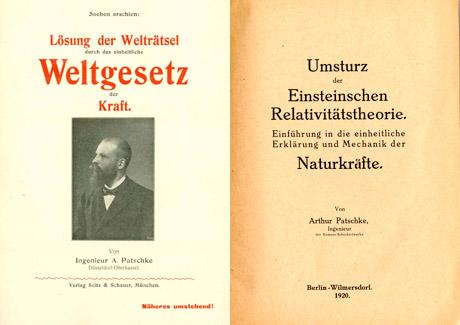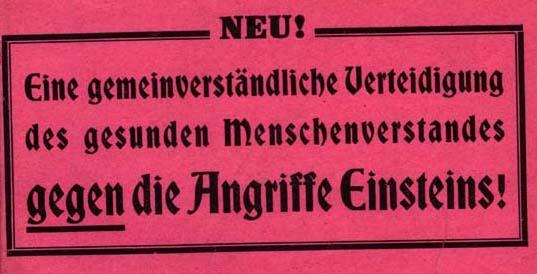Shortly after the confirmation of his theory of general relativity in 1919, Albert Einstein was transformed into a media star of Weimar Germany. The overwhelming public response to the theory of relativity was not always positive; numerous accounts published during the 1920s claimed to refute his new theory. Einstein’s opponents were not limited to physicists and philosophers. Engineers, doctors, businessmen, and writers also raised strong objections to one of the most important scientific theories of the twentieth century. What were the motives of Einstein’s opponents? On what basis was his theory of relativity attacked so vociferously? A recently accomplished project at the institute has investigated these questions.
Although they had previously played no role in German academic life, during the 1920s scores of self-proclaimed researchers alleged to have proved the theory of relativity to be scientifically incorrect. Because the arguments set out in hundreds of ensuing publications frequently rested on fundamental misunderstandings of Einstein’s new theory, their accounts have largely been ignored by traditional history of science. Instead, attention has focused on the criticisms of Einstein’s work put forward by physicists who clung to classical physics, and philosophers who saw central elements of their ways of understanding the world threatened by Einstein’s fundamental restructuring of the basic principles of physics. Moreover, “scientific” arguments leveled against the theory of relativity were separated from “unscientific” accounts, many of which were political attacks on the person of Albert Einstein, a German Jew and outspoken defender of Germany’s post-WWI democracy.
A fresh perspective emerges when popular criticism of the theory of relativity is investigated beyond the frame of physical or philosophical plausibility. By exploring criticisms of Einstein’s work from the perspective of a history of knowledge broadly conceived to investigate bodies of knowledge beyond scientific disciplines, we are in a better position not only to understand the various arguments advanced by Einstein’s opponents, but also the bodies of knowledge that provided the basis for these arguments and the social contexts in which their various objections arose.
This new scholarly approach to Einstein’s opponents reveals that criticism of the theory of relativity outside of academic circles began much earlier than the 1920s. The roots of this opposition can be traced back to the nineteenth century, when popularization of the natural sciences led many citizens to devote their leisure to the pursuit of scientific understanding. This leisure-time study of science led some individuals to create universal theories of their own; in some cases these simple, often mechanical explanations of the world enabled them to assemble a cadre of adherents drawn from a shared popular-scientific milieu.
One such self-proclaimed researcher and Einstein opponent is Arthur Patschke (1865–1934). Employed by Siemens Schuckert, a German electrical engineering company, Patschke saw himself as more than a design engineer of steam engines. Patschke was convinced that all phenomena—from the movement of the heavens to human thought itself—could be traced to the collisions of tiny ether particles. On this mechanical basis, Patschke went on to develop a scientific worldview in which ether attained a quasi-religious status as the key to the mysteries of the world.

Fig. 2: From 1905, the engineer Arthur Patschke began to publish articles in which he claimed to have solved the world’s mysteries. He also explained his mechanical theory at numerous public lectures. Patschke published his criticism of the theory of relativity in 1920, and sought to demonstrate that his “universal law of force” offered a much more compelling explanation of natural phenomena than Einstein’s theory of relativity.
It was by and large scholars outside academia such as Patschke who claimed, in numerous pamphlets published during the 1920s, to have refuted Einstein’s theory of relativity. Their accounts were situated in the context of worldviews such as monism, the naturalist-inspired Lebensreform movement, and occultism. Encompassing not only social forms of organization, these worldviews also covered specific bodies of knowledge. Against this background it becomes clear why popular criticism of the theory of relativity was often put forward by individuals with little or no understanding of Einstein’s theory, individuals who nonetheless approached the work of refutation with a particular vengeance. Shaped as they were by their worldviews, these individuals regarded Einstein’s theory of relativity as unwelcome competition to their own attempts to interpret the universe.
A non-academic researcher such as Patschke could not help but react defensively to the replacement of classical physics with one that has more abstract foundations. Patschke, for his part, sought to determine which elements of the theory of relativity could be reconciled with his ether theory. He also attempted to show which parts of the theory of relativity were demonstrably false by reference to his own abstractions.

Fig. 3: This banderole, or speech role, is part of an anti-Einstein pamphlet published in 1923. Einstein’s opponents felt threatened by the existence of the theory of relativity and legitimized their attacks as much-needed resistance.
The controversy surrounding the theory of relativity was exceptionally heated. In many pamphlets one finds what might be described as a martial rhetoric of damnation; his opponents also staged acts of protest that sought to inflame public opinion against Einstein’s work. A complex process of marginalization and protest helps to account for the heated responses to Einstein’s theory.
Non-academic researchers like Patschke announced public lectures, submitted essays, and tried to establish contact with Einstein and other leading scholars in order to warn them—as well-intentioned colleagues—of the falsehood of the theory of relativity and to convince them of the veracity of their own scientific worldviews. Patschke and others like him were often simply ignored; in other instances, it was patiently explained how their criticisms of the theory of relativity had completely missed the mark. But because their observations were anchored in specific worldviews, Patschke and his associates were immune to this type of criticism. Einstein’s opponents were simply not prepared to question their own worldviews and instead sought alternative explanations for why their objections were disregarded by the academics. With time, many turned to conspiracy to account for their marginal status: plots favoring Einstein, so they imagined, explained his success and their marginalization. Having reached this point, any sort of resolution of the controversy had become impossible.
Historical analysis of the controversy surrounding the theory of relativity shows that the fundamental restructuring of the basic principles of physics impacted not only science, but also modes of thinking far beyond academic circles as well. These bodies of knowledge—and the struggles waged by self-proclaimed scholars to have their findings recognized by physicists working within academic science—are the focus of my recent publication. This study is part of a larger project within the Institute.
